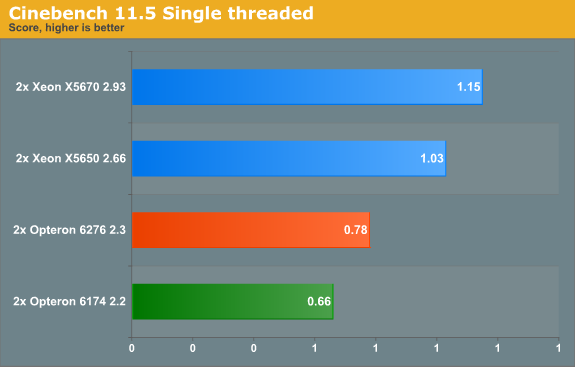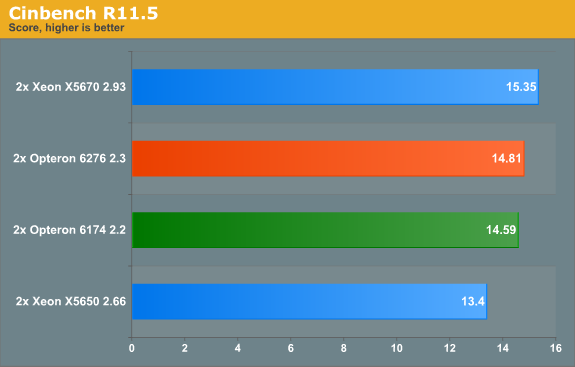Bulldozer for Servers: Testing AMD's "Interlagos" Opteron 6200 Series
by Johan De Gelas on November 15, 2011 5:09 PM ESTRendering Performance: Cinebench
Cinebench, based on MAXON's software CINEMA 4D, is probably one of the most popular benchmarks around, and it is pretty easy to perform this benchmark on your own home machine. The benchmark supports 64 threads, more than enough for our 24- and 32-thread test servers. First we tested single-threaded performance, to evaluate the performance of each core.

Single-threaded performance is relatively poor when you do not enable Turbo Core: with that setting the Opteron 6276 scores only 0.57. So the single-threaded FP performance is about 10% lower, probably a result of the higher FP/SSE latencies of the Interlagos FPU. However, the 6276 Opteron can boost the clock speed to 3.2GHz. This 39% clock speed boost leads to a 37% (!) performance boost. The difference with the older "Istanbul" based Opteron "Magny-cours" 61xx can only get larger once software with support for the powerful FMAC and AVX capable units is available. Also newer compilers will take the longer FP latencies into account and will probably boost performance by a few percent even without using FMAC or AVX.
Before we look at the Multi-threaded benchmark, Andreas Stiller, the legendary German C't Journalist ("Processor Whispers") sent me this comment:
"You should be aware that Cinebench 11.5 is using Intel openMP (libguide40.dll), which does not support AMD-NUMA"
So while Cinebench is a valid bench as quite a few people use the Intel OpenMP libraries, it is not representative of all render engines. In fact, Cinebench probably only represent the smaller part of the market that uses the Intel OpenMP API. On dual CPU systems, the Opteron machines run a bit slower than they should; on quad CPU systems, this lack of "AMD NUMA" awareness will have a larger impact.

We did not expect that the latest Opteron would outperform the previous one by a large margin. Cinebench is limited by SSE processing power. The ICC 11.0 compiler was the fastest compiler of its time for SSE/FP intensive software, even for the Opterons (up to 24% faster than the competing compilers), but it has no knowledge of newer architectures. And of course, the intel compiler does favor the Xeons.
The Opteron 6200 has a total of eight dual issue (if you count only those pipes that do calculations) FPUs, while the Opteron 6100 has a total of 12 dual issue FPUs. The only advantage that the 6200 has (if you do not use the FMAC or AVX capabilities) is that it can interleave two FP threads on one module. So you get 16 FP threads that can dispatch one FP per clock versus 12 FP threads that can dispatch two FP per clock. That capability is especially handy when your threads are blocked by memory accesses. This is hardly the case in Cinebench (but it is probably the reason why Interlagos does so well in some HPC tests) and as a result, the Opteron 6276 cannot pull away from the Opteron 6174.
Anand reported that the best Core i7 (2600K, 4 cores/8 threads, 3.4GHz) achieves 6.86. So considering that a dual Opteron 6200 is cheaper than the dual Xeon, and more manageable than two workstations, such a renderfarm may make some sense.










106 Comments
View All Comments
mino - Wednesday, November 16, 2011 - link
More workload ... also you need at least 3 servers for any meaningful redundancy ... even when only needing the power of 1/4 of iether of them.BTW. most cpu's sold in the SMB space are far cry from the 16-core monsters reviewed here ...
JohanAnandtech - Thursday, November 17, 2011 - link
Don't forget the big "Cloud" buyers. Facebook has increased the numbers of server from 10.000 somewhere in 2008 tot 10 times more in 2011. That is one of the reasons why the number of units is still growing.roberto.tomas - Wednesday, November 16, 2011 - link
seems like the front page write and this article are from different versions:from the write up: "Each of the 16 integer threads gets their own integer cluster, complete with integer executions units, a load/store unit, and an L1-data cache"
from the article: "Cores (Modules)/Threads 8/16 [...] L1 Data 8x 64 KB 2-way"
what is really surprising is calling them threads (I thought, like the write up on the front page, that they each had their own independent integer "unit"). If they have their own L1 cache, they are cores as far as I'm concerned. Then again, the article itself seems to suggest just that: they are threads without independent L1 cache.
ps> I post comments only like once a year -- please dont delete my account. every time I do, I have to register anew :D
mino - Wednesday, November 16, 2011 - link
I suits Intel better to call them threads ... so writers are ordered ... only if the pesky reality did not pop up here and there.BD 4200 series is an 1-chip, 4-module, 8(4*2)-core, 16(4*2)-thread processor
BD 6200 series is a 2-chip, 8(2*4)-module, 16(2*4*2)-core, 16(2*4*2)-thread processor
Xeon 5600 series is an (up to) 1-chip, 6-core, 12(6*2)-thread processor.
Simple as cake. :D
rendroid1 - Wednesday, November 16, 2011 - link
The L1 D-cache should be 1 per thread, 4-way, etc.The L1 I-cache is shared by 2 threads per "module", and is 2-way, etc.
JohanAnandtech - Thursday, November 17, 2011 - link
Yep. fixed. :-)Novality77 - Wednesday, November 16, 2011 - link
One thing that I never see in any reviews is remarks about the fact that more cores with lower IPC has added costs when it comes to licensing. For instance Oracle, IBM and most other suppliers charge per core. These costs can add up pretty fast. 10000 per core is not uncommon.....fumigator - Wednesday, November 16, 2011 - link
Great review as usual. I found all the new AMD opterons very interesting. Pairing two in a dual socket G34 would make a multitasking monster on the cheap, and quite future proof.Abour cores vs modules vs hyperthreading, people thinking AMD cores aren't true cores, should consider the following:
adding virtual cores on hyperthreading in intel platforms don't make performance increase 100% per core, but only less than 50%
Also if you look at intel processor photographs, you won't notice the virtual cores anywhere in the pictures.
While in interlagos/bulldozer you could clearly spot each core by its shape inside each module. What surprises me is how small they are, but that's for an entire different discussion.
MossySF - Wednesday, November 16, 2011 - link
I'm waiting to see the follow-up Linux article. The hints in this one confirm my own experiences. At our company, we're 99% FOSS and when using Centos packages, AMD chips run just as fast as Intel chips since it's all compiled with GCC instead of Intel's "disable faster code when running on AMD processors" compiler. As an example, PostgreSQL on native Centos is just as fast on Thuban compared to Sandy Bridge at the same GHz. And when you then virtualize Centos under Centos+KVM, Thuban is 35% faster. (Nehalem goes from 10% slower natively to 50% slower under KVM!)The compiler issue might be something to look at in virtualization tests. If you fake an Intel identifier in your VM, optimizations for new instruction sets might kick in.
http://www.agner.org/optimize/blog/read.php?i=49#1...
UberApfel - Wednesday, November 16, 2011 - link
Amazingly biased review from Anandtech.A fairer comparison would be between the Opteron 6272 ($539 / 8-module) and Xeon E5645 ($579 / 6-core); both common and recent processors.
Yet handpicking the higher clocked Opteron 6276 (for what good reason?) seems to be nothing but an aim to make the new 6200 series seem un-remarkable in both power consumption and performance. The 6272 is cheaper, more common, and would beat the Xeon X5670 in power consumption which half this review is weighted on. Otherwise you should've used the 6282 SE which would compete in performance as well as being the appropriate processor according to your own chart.
Even the chart on Page 1 is designed to make Intel look superior all-around. For what reason would you exclude the Opteron 4274 HE (65W TDP) or the Opteron 4256 EE (35W TDP) from the 'Power Optimized' section?
The ignorance on processor tiers is forgivable even if you're likely paid to write this... but the benchmarks themselves are completely irrelevant. Where's the IIS/Apache/Nginx benchmark? PostgreSQL/SQLite? Facebook's HipHop? Node.js? Java? Something relevant to servers and not something obscure enough to sound professional?